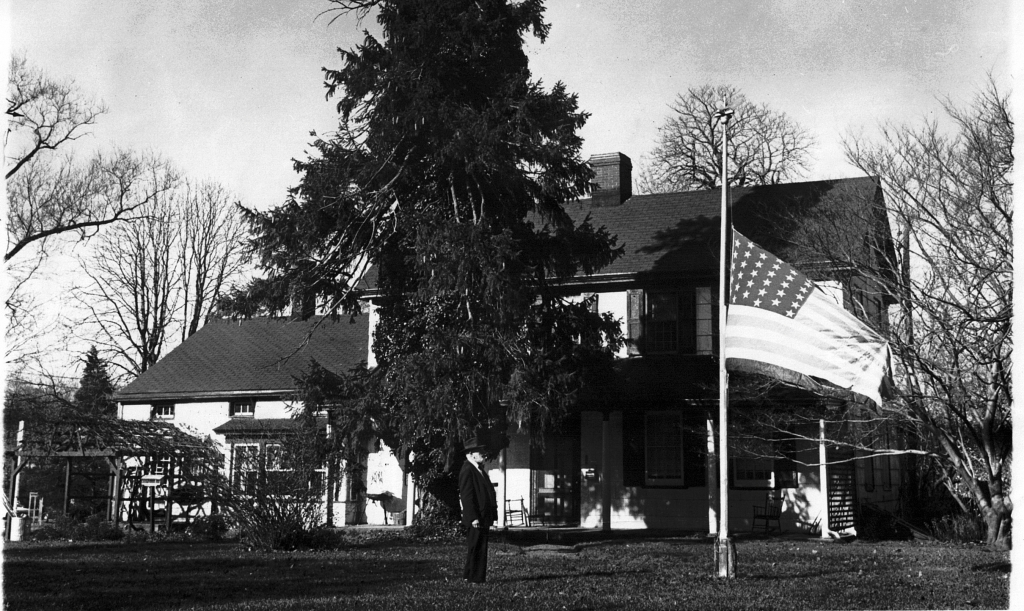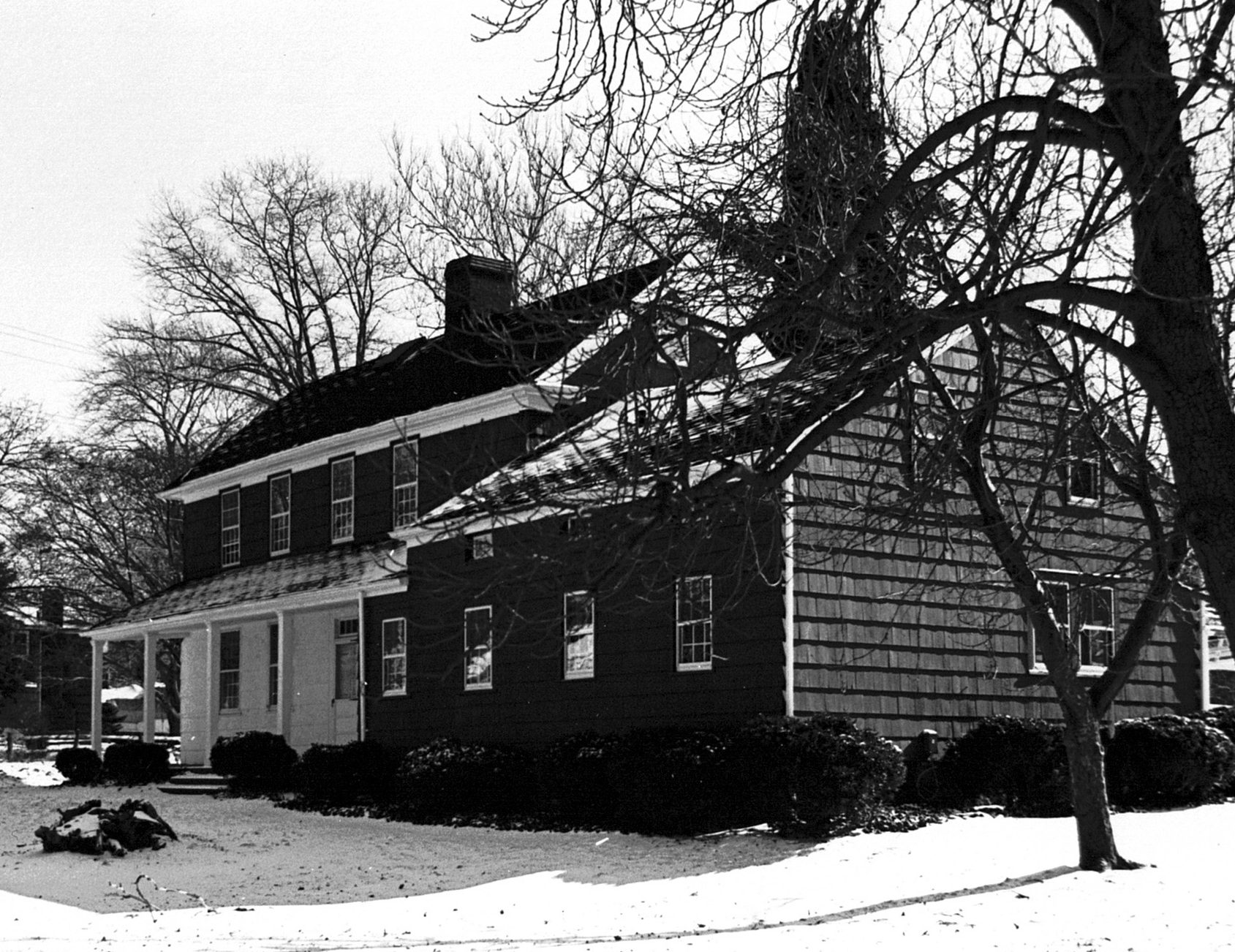In 1956, archeologists from Fordham University conducted digs at 187 Park Avenue where several Indian artifacts were found leading the archeologists to conclude that the property was the site of a Matinecock village. The Town Historian at the time speculated that this may have been the place where the First Purchase was signed. But there was no evidence to support that claim.

The house at 187 Park Avenue is said to have been built around 1740. Some accounts assert it was built as a wedding gift for Amelia Lloyd, but she wasn’t born until 1760. It is unclear what support there is for the 1740 construction date. The first deed for the property is dated 1811 when Amelia Lloyd sold the eight-acre property to Mary Long.
Amelia Lloyd married John Lloyd II in April 1783. John was 39, Amelia was a month shy of her 23rdbirthday. John had grown up on Lloyd Neck; Amelia in Danbury, CT. In September 1783, five months after their wedding, John wrote from Stamford to Amelia in Danbury. He advised of his plans to visit Long Island before “returning to the arms of my Amelia.” He said their separation must be “born with patience especially as it is to prepare a residence for the enjoyment of our mutual affections and esteem.” It has been supposed he was referring to the house on Park Avenue. However, it seems more likely that he was referring to the Manor House on Lloyd’s Neck, which he had inherited from his uncle, Joseph Lloyd. John Lloyd II died in 1792. Amelia may have purchased the Park Avenue house after his death. Indeed, a letter to her dated 1794 is addressed to her at the Manor of Queens Village, i.e. Lloyd’s Neck. A year later she received a letter addressed to her at Huntington, NY.
John, who had supported Independence, inherited much of the land on Lloyd Neck from his father and uncle, Joseph. That inheritance included Jupiter Hammon, the first published writer of African descent in the country, who had been enslaved by the Lloyd family since his birth in 1711.
As noted above, Amelia sold the Park Avenue property to Mary Long in 1811. She died seven years later in Danbury. The eight-acre parcel more or less ran from Park Avenue to the creek and from Creek Road south to Mill Lane.
Mary Long was the wife of cabinet maker Richard Long, who died in 1818. Mary Long sold the eight-acre parcel to William Coburn, who was also a cabinet maker. Coburn was one of the earliest members of the Methodist Church in Huntington. When a church was built in 1829 on Main Street, Methodists who lived near the harbor and didn’t wish to travel to the village for services, worshiped in the loft of Coburn’s cabinet shop, which was reportedly in the eastern most room of the house.
In 1833, Coburn sold the property to Elbert Walters, who was yet another cabinet maker. Walters was also one of the founders of the Huntington Mutual Fire Insurance Company and served as Overseer of the Poor and Town Trustee as well as school district trustee. In 1838, he raised a company of light infantry and was granted a Captain’s commission by the Governor, later promoted to Major. In addition to his wife and six children, two apprentices and two Black servants (one of whom was an 11-year-old girl) lived in the house.
Waters also acquired land on the west side of the Creek. From that property he sold small lots to Nelson Smith and Peter Crippen in 1854 and 1864 respectively. Smith and Crippen were founders of Bethel A.M.E. Church
According to William A. Rushmore, who lived in the house for almost 90 years, the original house is the four-bay east section. A small addition to the west proved too small and was replaced by the current west wing in the 1860s or 70s. The original west wing was moved to Creek Road where it was used by a Black family. This may have been used by one of the three Black families listed on the 1870 census on Creek Road–Peter Crippen, Nelson Smith and George Smith.
In 1865, Walters moved his shop to Wall Street and sold the Park Avenue property to Daniel K. Youngs of Oyster Bay. Youngs was a descendant of an old Long Island family–his ancestor hosted George Washington during the president’s 1790 tour of Long Island. Youngs was an expert agriculturalist. He was one of the founders of the Queens County Agricultural Society. In 1875, The Long-Islander pointed to Youngs’ gardens on Park Avenue as an example of the value of a good kitchen garden. According to his obituary in The Long-Islander, Youngs “was a thoroughly practical market gardener and his fields of onions, rhubarb and asparagus opened the eyes of many of the farmers in this vicinity of the possibilities and profits of market gardening.”
Youngs’ father died in 1874 and he seems to have then moved back to Oyster Bay. In 1877, Captain Meade, Commandant of the Marine barracks at the Brooklyn Navy Yard, leased the premises. Charles Kohlman leased the barn and gardens.
Youngs sold the house to William H. Rushmore on March 1, 1884 for $3,000 (Suffolk County Deed Liber 280, page 505). Thirty days later Rushmore sold the property to his cousin Rebecca J. Sutton for the same price (Suffolk County Deed Liber 280, page 507).

The cousins moved to Huntington from Brooklyn in 1880 following the death of Rushmore’s wife and Sutton’s husband. In the 1880 census, Rushmore and his two sons, William A. (age 12) and Henry (age 10) and Rebecca Sutton and her three children (ages 8 to 16) are listed as boarders in the household of Rebecca Sutton’s mother, Cornelia Sands.
Rushmore was in the brick business and later a stock broker. His son, William A. Rushmore, recalled an incident in 1888 when his father needed an operation for acute appendicitis. William, Sr.’s brother, who was a well-known surgeon in Brooklyn, performed in operation in the living room of the Lloyd House. William, Jr. reported that the doctors in Huntington were eager to watch the operation. William, Sr. died in 1918.
William A. continued to live in the house. He was born in 1867. He started work at the City Savings Bank in 1903 and stayed there until he retired in 1932 after he had a slight heart attack. As early 1899, William A. Rushmore was playing violin with the Huntington Orchestral Society. By 1907 he was hosting meetings of the Chess Club at his house. He joined the Huntington Yacht Club in 1925.
When a sewer plant was proposed for Huntington in 1914, he objected to the proposed location on Creek Road. In 1932 he was appointed to a committee to investigate problems at the sewer plant and possible expansion of the sewer district to include Halesite.
William A. didn’t acquire title to the house until 1947. Two years later he sold it to his cousin Marian Statesir Smith.
After President Kennedy was shot, William flew in front of his house an American flag with a black border that his grandmother had added when Abraham Lincoln was assassinated.

William A. died in 1968. The house was sold in 1973 to attorney Jordan Iserman, who converted it to office use. The Daniel Gale Real Estate Agency moved its offices there in November 1973. Kent Gale purchased the property less than a decade later. Although the Daniel Gale agency moved its offices to 263 Main Street in the summer of 2022, the Gale family continues to own the Amelia Lloyd House.

Leave a comment